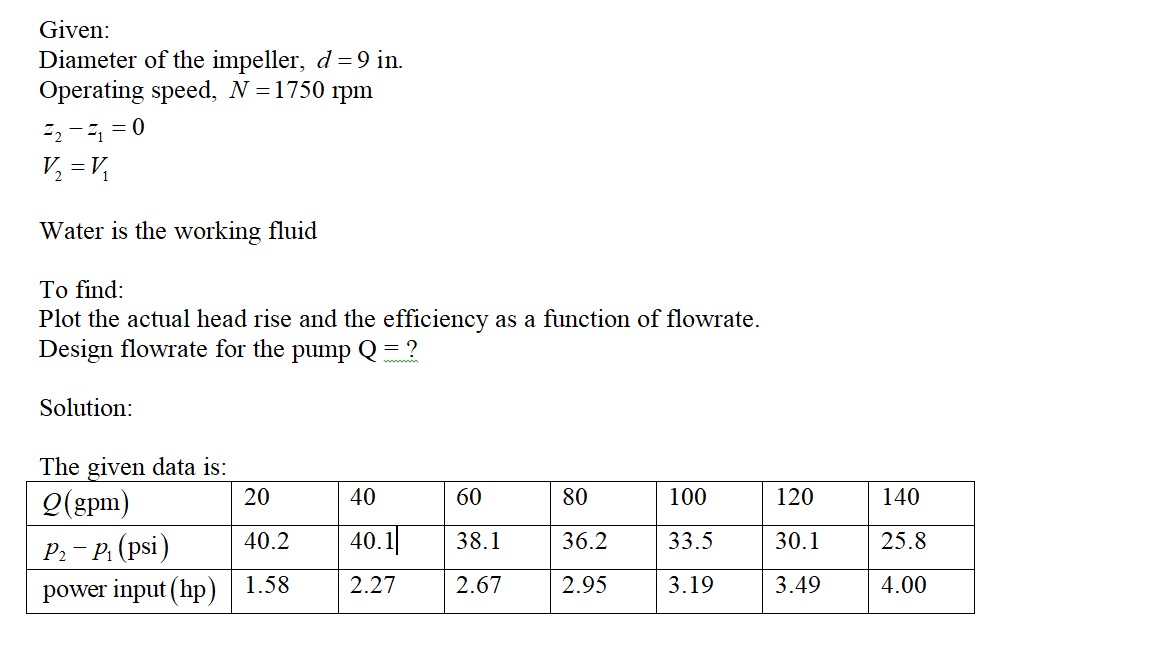12.18 WEY The performance characteristics of a certain centrifu- gal pump having a 9-in.-diameter impeller and operating at 1750 rpm are determined using an experimental setup similar to that shown in Fig. 12.10. The following data were obtained during a series of tests in which z₂z₁ = 0, V₂ = V₁, and the fluid was water. - 21 Q (gpm) 20 40 60 80 100 120 140 P2 - P₁ (psi) 40.2 40.1 38.1 36.2 33.5 30.1 25.8 Power input (hp) 1.58 2.27 2.67 2.95 3.19 3.49 4.00 Based on these data, show or plot how the actual head rise, ha, and the pump efficiency, n, vary with the flowrate. What is the design flowrate for this pump?
12.18 WEY The performance characteristics of a certain centrifu- gal pump having a 9-in.-diameter impeller and operating at 1750 rpm are determined using an experimental setup similar to that shown in Fig. 12.10. The following data were obtained during a series of tests in which z₂z₁ = 0, V₂ = V₁, and the fluid was water. - 21 Q (gpm) 20 40 60 80 100 120 140 P2 - P₁ (psi) 40.2 40.1 38.1 36.2 33.5 30.1 25.8 Power input (hp) 1.58 2.27 2.67 2.95 3.19 3.49 4.00 Based on these data, show or plot how the actual head rise, ha, and the pump efficiency, n, vary with the flowrate. What is the design flowrate for this pump?
Elements Of Electromagnetics
7th Edition
ISBN:9780190698614
Author:Sadiku, Matthew N. O.
Publisher:Sadiku, Matthew N. O.
ChapterMA: Math Assessment
Section: Chapter Questions
Problem 1.1MA
Related questions
Question
Please list any assumptions and answer all parts

Transcribed Image Text:12.18 WEY The performance characteristics of a certain centrifu-
gal pump having a 9-in.-diameter impeller and operating at 1750 rpm
are determined using an experimental setup similar to that shown in
Fig. 12.10. The following data were obtained during a series of tests
in which z₂ Z₁ = 0, V₂ = V₁, and the fluid was water.
Q (gpm)
20 40 60 80 100 120 140
25.8
P2 - P₁ (psi) 40.2 40.1 38.1 36.2 33.5 30.1
Power input (hp) 1.58 2.27 2.67 2.95 3.19 3.49 4.00
Based on these data, show or plot how the actual head rise, ha, and
the pump efficiency, n, vary with the flowrate. What is the design
flowrate for this pump?
(1).
Figure 12.10
(2)
22-21
1
Expert Solution
Step 1

Trending now
This is a popular solution!
Step by step
Solved in 9 steps with 11 images

Knowledge Booster
Learn more about
Need a deep-dive on the concept behind this application? Look no further. Learn more about this topic, mechanical-engineering and related others by exploring similar questions and additional content below.Recommended textbooks for you

Elements Of Electromagnetics
Mechanical Engineering
ISBN:
9780190698614
Author:
Sadiku, Matthew N. O.
Publisher:
Oxford University Press

Mechanics of Materials (10th Edition)
Mechanical Engineering
ISBN:
9780134319650
Author:
Russell C. Hibbeler
Publisher:
PEARSON

Thermodynamics: An Engineering Approach
Mechanical Engineering
ISBN:
9781259822674
Author:
Yunus A. Cengel Dr., Michael A. Boles
Publisher:
McGraw-Hill Education

Elements Of Electromagnetics
Mechanical Engineering
ISBN:
9780190698614
Author:
Sadiku, Matthew N. O.
Publisher:
Oxford University Press

Mechanics of Materials (10th Edition)
Mechanical Engineering
ISBN:
9780134319650
Author:
Russell C. Hibbeler
Publisher:
PEARSON

Thermodynamics: An Engineering Approach
Mechanical Engineering
ISBN:
9781259822674
Author:
Yunus A. Cengel Dr., Michael A. Boles
Publisher:
McGraw-Hill Education

Control Systems Engineering
Mechanical Engineering
ISBN:
9781118170519
Author:
Norman S. Nise
Publisher:
WILEY

Mechanics of Materials (MindTap Course List)
Mechanical Engineering
ISBN:
9781337093347
Author:
Barry J. Goodno, James M. Gere
Publisher:
Cengage Learning

Engineering Mechanics: Statics
Mechanical Engineering
ISBN:
9781118807330
Author:
James L. Meriam, L. G. Kraige, J. N. Bolton
Publisher:
WILEY